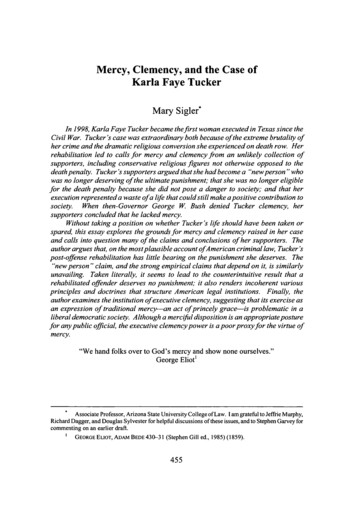
Transcription
Mercy, Clemency, and the Case ofKarla Faye TuckerMary Sigler*In 1998, KarlaFaye Tucker became thefirst woman executed in Texas since theCivil War. Tucker's case was extraordinaryboth because ofthe extreme brutalityofher crime and the dramaticreligious conversionshe experienced on death row. Herrehabilitation led to calls for mercy and clemency from an unlikely collection ofsupporters, including conservative religiousfigures not otherwise opposed to thedeathpenalty. Tucker's supportersarguedthat she had become a "newperson" whowas no longer deserving of the ultimatepunishment; that she was no longer eligiblefor the death penalty because she did not pose a danger to society and that herexecution representeda waste ofa life thatcould still make apositivecontributiontosociety. When then-Governor George W. Bush denied Tucker clemency, hersupportersconcluded that he lacked mercy.Without taking a position on whether Tucker's life should have been taken orspared, this essay explores the groundsfor mercy and clemency raisedin her caseand calls into question many of the claims and conclusions of her supporters. Theauthorargues that, on the mostplausibleaccount ofAmerican criminallaw, Tucker'spost-offense rehabilitationhas little bearing on the punishment she deserves. The"new person " claim, and the strong empirical claims that depend on it, is similarlyunavailing. Taken literally, it seems to lead to the counterintuitive result that arehabilitatedoffender deserves no punishment; it also renders incoherent variousprinciples and doctrines that structure American legal institutions. Finally, theauthorexamines the institutionofexecutive clemency, suggesting that its exercise asan expression of traditionalmercy-an act of princely grace-isproblematic in aliberaldemocraticsociety. Although a merciful dispositionis an appropriateposturefor any public official, the executive clemency power is apoorproxyforthe virtue ofmercy."We hand folks over to God's mercy and show none ourselves."George Eliot1Associate Professor, Arizona State University College of Law. I am grateful to Jeffrie Murphy,Richard Dagger, and Douglas Sylvester for helpful discussions of these issues, and to Stephen Garvey forcommenting on an earlier draft.I GEORGE ELIOT, ADAM BEDE 430-31 (Stephen Gill ed., 1985) (1859).
OHIO STATE JOURNAL OF CRIMINAL LAW[Vol 4:455I. INTRODUCTIONIt has been almost ten years since the State of Texas executed Karla Faye Tucker.Tucker's case, which began with a brutal double murder, garnered internationalattention for several reasons. First, Tucker's crimes were especially grisly. She andher boyfriend hacked and hammered to death a defenseless couple lying in bed;Tucker later bragged that she experienced multiple orgasms while delivering thedeadly blows with an ax. In addition, because Tucker was a woman, the prospect ofher execution seemed to tap our collective squeamishness about putting a woman todeath. Although Texas leads the nation in the number of executions it carries out, ithad not (until Tucker) executed a female capital offender since 1863.2 But theprimary reason Tucker's case gained worldwide attention was her complete-andapparently sincere-conversion to Christianity during the course of her trial andsentencing. Within four months of her arrest, Tucker professed to have found the"power of forgiveness;3 to have repented of her crimes; and to have begun aprofound transformation 4culminating in the claim, by herself and others, that she hadbecome a "new person.",Tucker's conversion led to calls for mercy, clemency, and the invalidation of hersentence. The legal argument was that Tucker's rehabilitation rendered the deathpenalty inappropriate in her case because she no longer posed a danger to society. 5More generally, her supporters argued that Tucker was, in some important respect, nolonger the individual who committed the crimes and was thus no longer deserving ofthe ultimate punishment. Moreover, because of the good works she had begun toperform from her prison cell-counseling inmates and other troubled souls-herexecution would represent the waste of a life that could still make a positivecontribution to society.6Despite these appeals, Tucker was executed on February 3, 1998. In a 2005essay, Sister Helen Prejean, author of Dead Man Walking and a Tucker confidante,2Kathy Walt, Tucker Dies After Apologizing; DespiteLegal Blitz, Woman ExecutedforPickaxSlayings, HOUSTON CHRON., Feb. 4, 1998, at Al.3 See LINDA STROM, KARLA FAYE TUCKER SET FREE 45-65 (2000).4 See, e.g., Orville Scott, An Execution Cost Us a Living Testimony to the GraceofGod, DALLASMORNING NEWS, Feb. 7, 1998, at 4G (noting that reporters and others who encountered Tucker after herconversion regarded her as a "new person"); Tunku Varadaraj an, America Split as Execution LoomsforConvert, Murderer,TIMES (U.K.), Jan. 31, 1998, at 15 (quoting Tucker's claim that she "became a newperson. [I]t was as if God opened me up and took the evil out, and then poured himself into me.");Eric Zom, Death Row Beauty Shows Execution Is Always Unfair, CHI. TRIB., Jan. 22, 1998, at 1("Executing this new person would be an abomination; pure symbolism that accomplishes nothing andbrutalizes our society."); see also discussion infra Part III.A.5 Application/Petition for Post-Conviction Writ of Habeas Corpus, ExparteTucker, 973 S.W.2d950 (1998) (Tex. Crim. App. 1998) (No. 038842801010) [hereinafter Tucker Brief].6 See, e.g., Walter C. Long, Karla Faye Tucker: A Casefor RestorativeJustice, 27 AM. J. CRIM.L. 117, 121-22 (1999) (describing Tucker's record of good works).
2007]MERCY, CLEMENCY, AND THE CASE OFKARLA FAYE TUCKER457revived the debate over her case in moral, political, and religious terms. 7 Accordingto Prejean, over the course of Tucker's case then-Governor George W. Bush revealedhimself to be a callous hypocrite and a liar:When I heard Bush say, "God bless Karla Faye Tucker," I had to struggle tokeep a vow I made to reverence every person, even those with whom Idisagree most vehemently. Inside my soul I raged at Bush's hypocrisy ."It's interesting to see that Governor Bush is now invoking God, askingGod to bless Karla Faye Tucker, when he certainly didn't use the power inhis own hands to bless her. He just had her killed."'Stripped of the anti-Bush sentiment, Prejean's charge is a familiar one. Amongthe most compelling themes in literature, scripture, and the philosophical tradition aremercy, repentance, and redemption: Only the coldest heart is unmoved by sincererepentance; no person or people wishes to be merciless; no human being is beyondredemption; it is wrong, if not also unjust, to withhold mercy from an individual whohas, against all odds, rehabilitated himself. What good is achieved by extinguishingsuch a life?Prompted by Sister Prejean's resurrection of Tucker's case, I shall explore thecontours and limitations of mercy and clemency in the criminal law. Enough time haspassed since her execution that it should be possible to get a fresh perspective on thishigh profile case. At the same time, the facts of Tucker's case implicate a range ofconsiderations that are persistently controversial and perennially salient in judgmentsof mercy and clemency. Is Eliot (and Prejean) right that there's a kind of hypocrisy inour invocation of God's mercy when we decline to dispense our own? Does mercyrequire clemency?After briefly setting forth the details of Tucker's case, I review the legal, moral,and political arguments raised on her behalf. Dominating these arguments was theclaim that Tucker's conversion and rehabilitation rendered her a new person"ineligible" 9 for the death penalty. How much, if at all, are we justified in punishing atruly repentant wrongdoer? Next I review the various justifications for punishmentthat animate American criminal law, focusing particular attention on competingversions of retributivism and their implications for questions of mercy and clemency.Despite the appeal of certain aspects of "character retributivism," I argue that "choiceretributivism" better captures both the practices and principles of the criminal law. Ithen examine the grounds for mercy and clemency raised in Tucker's case andevaluate them in terms of the retributive justification for punishment. None leadsinexorably to the conclusion that Tucker's life should have been spared.Sister Helen Prejean, Death in Texas, N.Y. REV. BooKs, Jan. 13, 2005.8 Id. at 4, 5 (quoting herself). Prejean also maintains that Bush's "callous indifference to humansuffering" sets him apart from other governors who have denied appeals for clemency and that Bush liedabout his emotional reaction to Tucker's execution, "claiming humane feelings he never felt." Id. at 6.9 Tucker Brief, supra note 5, at 17.7
OHIO STATE JOURNAL OF CRIMINAL LA W[Vol 4:455Apart from the dubious arguments for clemency raised in Tucker's case, thepower of executive clemency itself merits closer scrutiny. Hailed by some as the "lastvestige of the divine right of kings,"'0 the power of clemency is at best problematic ina liberal democratic society. Despite its virtues as a fail safe, the power is grounded indiscredited political rationales and prone to abuse. Finally, because the question ofclemency is distinct from the question of mercy, we should be especially circumspectin our judgments about those who grant or withhold them. Although the wholesalerejection of mercy signals a flawed character, the rejection of clemency in particularcases does not. A merciful disposition, like the invocation of God's mercy, does notentail any particular judgment about clemency. Regardless of whether Tucker's lifeshould have been taken or spared, it is a mistake to confuse God's justice with ourown.A. Background1. Crime, Trial, and Conversion"At the age of twenty-three, Karla Faye Tucker was a drug addict and a veteranprostitute. On the night of the murders, she and her friends had been partying forthree days, consuming large quantities of alcohol, pills, cocaine, and speed. At somepoint during the weekend, Tucker's close friend Shawn arrived at the party with abroken nose and a fat lip from her estranged husband, Jerry Dean. Tucker alreadyhated Dean, who had once parked his motorcycle in her living room. On one occasionTucker had punched Dean in the face, shattering his glasses and sending him to thehospital for treatment. Over the course of the weekend, Tucker, her boyfriend DanielGarrett, and another friend, Jimmy Leibrant, began plotting revenge against Dean.On the night of the murders, as the party wound down, Tucker and Leibrantdrove Garrett to work. When they picked him up at two o'clock in the morning, theysettled on a plan to get even with Jerry Dean by stealing his beloved motorcycle.According to Tucker, the trio had no intention of killing Dean when they set out forhis apartment in the middle of the night. 12 But once inside the apartment, their planchanged when Dean woke up. Garrett armed himself with a hammer from Dean'stoolbox and attacked him in the bedroom. Tucker followed with a pick ax. She struckboth Dean and his companion, Deborah Thornton, repeatedly with the ax. When the10 Prejean,supranote 7, at 4.1 This account of events is taken from BEVERLY LOWRY, CROSSED OVER: A MURDER, A MEMOIR(1992); Joseph Geringer, Karla Faye Tucker: Texas' ControversialAx Murderess, at /tucker/.html (last visited June 12, 2006); Karla FayeTucker #437, at 437.htm (last visited June 12,2006) (compiling official press releases and news accounts of Tucker's case).12 See Beverly Lowry, The GoodBad Girl,THE NEW YORKER, Feb. 9, 1998, at 47 (reporting herconversations with Tucker).
2007]MERCY, CLEMENCY, AND THE CASE OFKARLA FAYE TUCKER459bodies were discovered later that morning, each had been struck more than twentytimes with the ax, which was left embedded in Thornton's chest.In the days that followed, Tucker and Garrett bragged about the murders tofamily and friends. Investigators eventually linked Tucker and Garrett to the murders,assisted by Garrett's brother, who taped the two discussing their crimes. Tucker isheard on the tape claiming to have experienced a sexual thrill with each swing of theax. In separate trials in 1984, both Tucker and Garrett wereconvicted of murder in3'death.tosentencedandrobberyarmedanofthe courseBy the time of her trial and sentencing, Tucker had converted to Christianity.According to Tucker, her conversion began about three months after her arrest when aChristian ministry visited the jail where she was being held. At her trial, Tuckeradmitted her responsibility for the murders; she later testified against Garrett. By thetime she arrived on death row, Tucker had become a counselor to other inmates,reportedly offering them psychological support and assisting their families throughprison ministry work. In 1995, she married Dana Brown, a prison minister.2. Legal ContextOn direct appeal, Tucker unsuccessfully challenged numerous aspects of herconviction and sentencing, arguing, among other things, that she lacked the culpabilityfor capital murder; that she was denied a fair trial based on certain evidentiary rulings;and that the jury was improperly instructed regarding mitigating evidence that mighthave resulted in a sentence less than death. 14 In subsequent proceedings, Tuckerunsuccessfully sought state and federal habeas relief; moved for a new trial based on aclaim of ineffective assistance of counsel; and challenged Texas clemency proceduresas a violation of due process.' 5Once Tucker had exhausted these avenues of legal recourse, some fourteen yearsafter the murders, her only possibility of avoiding the death penalty was executiveclemency. At that time, Texas had executed 144 offenders since the reinstatement ofthe death penalty in 1976, but "not a single death sentence ha[d] been commutedsolely by request of the condemned." 16 As governor, George W. Bush's statedclemency policy limited consideration to two issues: whether there was doubt about adefendant's guilt, and whethera defendant had "fair access to the courts on alloutstanding legal issues."' 17 Although Bush later commuted the sentence of an inmate13 Garrett died of natural causes in 1993. See Kathy Fair & Carol Rust, Death Row Inmate Diesof Natural Causes; 10 Years after Conviction in Pickax Murders, PrisonerWas to Receive New Trial,HOUS. CHRON., June 16, 1993, at A21.14 See Tucker v. State, 771 S.W.2d 523 (Tex. Crim. App. 1988).'5 See Tucker v. Johnson, 115 F.3d 276 (5th Cir. 1997); ExparteTucker, 973 S.W.2d 950(1998)(Tex. Crim. App. 1998).16 Exparte Tucker, 973 S.W.2d at 954 (Baird, J., dissenting).17 Stephanie Asin & Kathy Walt, Execution of Tucker Scheduledfor Feb. 3, Hous. CHRON., Dec.19, 1997, at Al (quoting Bush spokesperson Karen Hughes).
460OHIO STATE JOURNAL OF CRIMINAL LA W[Vol 4:455due to doubts about his guilt,1 8 he had not, at the time of the Tucker case, evercommuted a death sentence.B. The Casefor ClemencyAs the legal challenges mounted, and the prospect of her execution loomed,Tucker became a media sensation.1 9 Among the most outspoken-and unexpectedof her supporters was the Reverend Pat Robertson of the Christian BroadcastingNetwork. Robertson's account of Tucker's conversion sounded the theme that cameto dominate the case for clemency:During that period [of trial and appeals], she had a profound conversionexperience, and when we sent a reporter down to talk to her [in 1992], wedidn't find some wild-eyed hippie, we found the most beautiful Christianwoman we had ever encountered. sublime, if I can use that term, a lovelyspirit. The person who had committed those crimes really wasn't thereanymore. She was like a different person, and when we interviewed her andshowed her testimony on television, and others did the same thing, theyfound a person who was absolutely radiant. It was so impressive, actually,that during her time of incarceration, she married the assistant chaplain ofthe prison. Even though they couldn't have physical contact with eachother,20they got married anyhow, because there was a bond of love betweenthem.Robertson's various appeals focused on Tucker's transformation from a drug-addictedprostitute to a "beautiful Christian woman." As early as 1992, Robertson's programThe 700 Club featured the transformed Tucker describing her conversion experience;in subsequent appearances, she spoke of her wish to avoid the death penalty, butreiterated her faith in God's plan for her, come what may.2'All of Tucker's supporters, including Tucker herself, emphasized that herconversion rendered her a "new person." A member of the jury that voted to executeher also noted the transformation: "I'm not saying that at the time it was wrong to give18 Bruce Tomaso & David McLemore, Bush Spares Lucas from Death Penalty: GovernorCommutes Sentence to Life, Cites Doubts over Guilt, DALLAS MORNING NEWS, June 27, 1998, at IA.'9 Over the course ofher incarceration, Tucker's case generated two separate rounds of media andpublic attention. Shortly after she was first scheduled for execution in 1992, she appeared in a tapedinterview for The 700 Club on the Christian Broadcasting Network. The appearance, and related mediacoverage, resulted in a massive letter-writing campaign to then-Governor Ann Richards, urging clemencyfor Tucker. As her 1998 execution date approached, a deluge of letters and public appeals againinundated the Governor's office. See Mike Ward, In Eye of Controversy,A Woman 's Execution, AUSTINAM.-STATESMEN, Dec. 6, 1997, at Al.20Pat Robertson, Transcript of Speech on Religion's Role in the Administration of the DeathPenalty, 9 WM. & MARY BILL. RTS.J. 215, 217 (2000).2The 700 Club (CBN television broadcast, Feb. 4, 1998) (Karla Faye Tucker, guest).
2007]MERCY, CLEMENCY, AND THE CASE OFKARLA FAYE TUCKER461her the death penalty; she did deserve it at that time. But things have changed. Shehas changed. 2 2 An attorney involved in the prosecution of Daniel Garrett agreed:"The Karla Tucker who killed Jerry Dean and Deborah Thornton cannot be executedby the State of Texas because that person no longer exists. The Karla Tucker whoremains on death row is a completely different person who, in my opinion, is notcapable of those atrocities." 23 Finally, according to Tucker herself, "[t]he otherKarla"-the one who murdered two people-"no longer exists. 24 In a brief filed inthe Texas Court of Criminal Appeals, her attorneys pressed the point in the strongestpossible terms: "The fact that someone, in society's view, may have 'deserved' to diefor the offense does not support the execution of [Tucker] if she truly is no longer thesame moral entity alleged to have committed the offense. 25A corollary of the "new person" claim was that because of her transformation,Tucker no longer posed a danger to society. Thus, according to her supporters, theimposition of the death penalty could serve no legitimate purpose and insteadamounted to the needless infliction of suffering. Indeed, under Texas law, as a basisfor a death sentence a jury must find "a probability that the defendant would commitcriminal acts of violence that would constitute a continuing threat to society. 26Whatever the case at the time of trial and sentencing, after fourteen years on death27row, supporters argued, Tucker was no longer capable of violence. According toone attorney's submission in support of her commutation: "I am comfortable enoughin this belief [that Tucker is no longer dangerous] that, if possible, I would welcome2928Several prison guards echoed this view.Karla into my house to meet my family.A further basis for clemency, according to Tucker's supporters, was her capacityto make a positive contribution to society. During her many years of incarceration,Tucker befriended and counseled other inmates, reached out to troubled young people,and actively participated in prison ministry activities. According to one of herattorneys, Tucker "offer[ed] herself to anyone who needed a compassionate and wiselistener" and "actively counseled scores of people struggling with their own issues ofsin and forgiveness. 3 In a letter to Governor Bush, Tucker vowed that if hersentence were commuted, she would "continue for the rest of [her] life in this earth to2260 Minutes: Inmate 777 (CBS television broadcast, Dec. 7, 1997) [hereinafter 60 Minutes)(Paul Ward, guest).23Long, supra note 6, at 121 (quoting Assistant Harris County District Attorney CharleyDavidson); see also 60 Minutes, supra note 22 (Texas Detective J.C. Mosier, guest, stating "[S]he iscertainly not the woman she was when I arrested her.").24 60 Minutes, supra note 22 (Karla Faye Tucker, guest); see also Prejean, supra note 7, at 5(reporting Tucker's claim that, in following Christ, she had become a "new creation").25 Tucker Brief, supra note 5, at 17.26TEX. CODE CRIM. PROC. ANN. art. 37.071 (Vernon 2006).27Long, supra note 6, at 121.28Id. (quoting Davidson).29Id.3Id. at 126.
OHIO STATE JOURNAL OF CRIMINAL LAW[Vol 4:455reach out to others to make a positive difference in their lives.'In this small way,she hoped "to pay society back by helping others." 32 Sister Prejean lamented that, butfor her execution, Tucker "would have been a source of healing love to guards andprisoners as long as she lived. 33Although the case for clemency was generally cast in terms of Tucker'srehabilitation, several other factors seemed to play a supporting role. References toTucker, by her supporters and the media, invariably mentioned her appearance,especially her gender and good looks, as well as her Christian faith.34 Pat Robertsongushed that Tucker was "absolutely radiant," "the most beautiful Christian woman wehad encountered. sublime." 35 Sister Prejean observed that "[o]n television screensacross America, people saw Karla Faye Tucker's beautiful face as she talked aboutreading the Bible in her prison cell. and discovering Jesus. '36 News accounts notedher "sometimes-angelic smiling face and twinkling eyes,, 37 her "'girl-next-door'attractiveness,"38 and her "highly sexual charm. 3 9 At least one Tucker supporterReverend Jerry Falwell-admitted that he objected to Tucker's execution partlybecause she was a woman.4 As a "beautiful Christian woman," Tucker seemed to gamer more sympathy thanthe average death row inmate. "She was a woman, white, attractive, articulate and aChristian," one commentator noted. "A lot of people on death row have three of thosecharacteristics; some have four. But very few have all five . ,4' Even other31 Excerptsfrom KarlaFaye Tucker'sLetterto Governor Bush, Hous. CHRON., Jan. 21, 1998, atA25 [hereinafter Tucker 's Letter].32Id.33 Prejean, supra note 7, at 5.34 See, e.g., S.C. Gwynne Austin, KarlaFaye Tucker: Why So Many Want to Save Her,TIME, Jan.19, 1998 (describing the "attractive, sweet-natured, born-again Christian"); Scott, supra note 4 (callingTucker "one of God's loveliest saints"); Sam Howe Verhovek, Divisive Case ofa Killer of Two Ends asTexas Executes Tucker: First Woman Put to Death There Since Civil War, N.Y. TIMES, Feb. 4, 1998, atA l (noting Tucker's "doe-eyed good looks"); Walt, supranote 2 (noting that Tucker "charmed televisionaudiences worldwide with her coquettish smile and talk of Jesus"); Zorn, supra note 4 (discussing "thebeauteous Karla Faye Tucker").35 Robertson, supranote 20, at 217.36 Prejean, supra note 7, at 5.37 Walt, supra note 2.38 Court TV Online, Texas v. KarlaFaye Tucker: A Question ofMercy, http://www.courttv.com/archive/ casefiles/tucker/background.htmi (last visited Aug. 15, 2006).39 Lowry, supra note 12, at 60, 61.40 Crossfire: Has Execution of KarlaFaye Tucker ChangedAmerica's Death Penalty Debate?(CNN television broadcast, Feb. 4, 1988) (Jerry Falwell, guest, stating "I have to be honest about it, [her]being a woman did make a difference to me."); see also id. ("I still look on women differently than I domen.").41 Sam Howe Verhovek, Karla Tucker Is Now Gone, but Several Debates Still Linger, N.Y.TIMES, Feb. 5, 1998, at A 12 (quoting University of Houston Law Professor David R. Dow).
2007]MERCY, CLEMENCY, AND THE CASE OFKARLA FAYE TUCKER463women on death row at the same time as Tucker, including those with dramaticconversion stories, did not receive the same level of public attention and support.42Although Tucker's bid to avoid execution was unsuccessful, she and hersupporters mounted an impassioned case for clemency. In the wake of her execution,Tucker supporters hardened into Bush critics, who charged that the Governor, and byextension, the State of Texas, altogether lacked mercy. Before evaluating this claim, Iwill attempt to step back from the emotionally charged atmosphere of thiscontroversial execution and consider the broader philosophical context it implicates,including the justifications for punishment in American criminal law as well as thegrounds for mercy.II.PUNISHMENT AND MERCYThe traditional justifications for punishment generally fall into two categories:utilitarian43 and retributive. 4 The principal utilitarian justifications-incapacitation, 5deterrence, 46 and rehabilitation, 7-are defended in terms of the positive consequences42In Texas, Erica Sheppard, a twenty-four year-old black mother of three, was convicted ofstabbing and bludgeoning a woman in order to steal her car. Having waived her appeals, Sheppard wasoriginally scheduled for execution shortly after Tucker. Following a religious experience, Sheppardchanged her mind and remains on death row appealing her sentence. Michael Graczyk, Jesse JacksonVisits Woman on Death Row, DALLAS MORNING NEWS, Apr. 9, 1998, at 18A. One month after Tuckerwas executed, Florida electrocuted Judi Buenoano, the first woman executed in the State since 1857.Buenoano was convicted of murdering her husband and disabled son in separate incidents. Like Tucker,she became a devout Christian and led a productive existence on death row. As one of Buenoano'srelatives noted, "[Judi] may not have been as photogenic, as young or as pretty as Karla, but she was justas good a Christian." Judias V. Buenoano 450, at ano450.htm (last visited July 26, 2006) (compiling official press releases and news accounts ofBuenoano's case). Similarly, with her close-cropped hair and black skin, Sheppard seemed to lackTucker's broad appeal.43 Utilitarianism is the most prominent form ofconsequentialism, the view that actions should beevaluated in terms of their consequences. For the utilitarian, the consequence to be maximized ishappiness-or utility.44 See MICHAEL MOORE, PLACING BLAME 92 (1997) [hereinafter MooRE, PLACING BLAME](identifying "two sorts of prima facie justifications of punishment-effecting a net social gain(utilitarian), and giving just deserts (retributivist)").45 Incapacitation involves disabling an offender from engaging in further criminal conduct. Themost obvious forms of incapacitation are imprisonment and execution; in both cases, offenders arephysically prevented from offending again. See, e.g., Jeremy Bentham, Panopticon Versus New SouthWales, in 4 THE WORKS OF JEREMY BENTHAM 183 (John Browning ed., Russell & Russell, Inc. 1962)(1838) ("This contrivance [incapacitation] was as firmly laid in school-logic as could be wished.Mischievously or otherwise, for a body to act in aplace, it must be there.").46 Deterrence may be either "general" or "specific." General deterrence concerns the "preventionof similar offenses on the part of individuals at large, viz. by the repulsive influence exercised on theminds of bystanders by the apprehension of similar suffering in case of similar delinquency." Specificdeterrence is "prevention of similar offenses on the part of the particularindividual punished in eachinstance, viz. by curing him of the will to do like in the future." See id at 174.
OHIO STATE JOURNAL OF CRIMINAL LAW[Vol 4:455they are believed to bring about. In the case of deterrence, for example, its viability asajustification for punishment is measured in terms of its efficacy in achieving the goalof crime prevention by means of the threat of punishment. Retributivism, by contrast,is centrally concerned with the imposition of suffering in proportion to an offender'smoral desert.48 On this view, punishment of the deserving is intrinsically good; itsjustification does not depend on any further positive consequences that punishmentmight be expected to produce. Thus, a "retributivist punish[es] because, and only49because, offenders deserve it."In the death penalty context, the dominant justifications for punishment aredeterrence and retribution. Although deterrence figures prominently in the SupremeCourt's capital sentencing jurisprudence50 and in public support for the deathpenalty, 51 it remains controversial whether the death penalty actually deters would-bemurderers.52 Moreover, deterrence alone does not seem fully to account for people'sintuitions about justice. In principle, deterrence might justify punishment of theinnocent if it would yield sufficient deterrent effects. By the same token, a singularconcern for deterrence might result in a decision to forgo punishment of the guilty incases where punishment would not achieve deterrence.Retribution, by contrast, has a strong intuitive appeal-that the deserving shouldbe punished is practically a tautology. It is less obvious what desert consists in,however, and how precisely to measure it. Indeed, in the absence of an independentmetric for gauging proportionality, we are left to rely largely on intuition and47 Rehabilitation concerns the attempt to reform a wrongdoer, either in Bentham's sense-by'curing" the offender of the impulse to engage in wrongdoing-or by otherwise reforming an "offender'scharacter, habits, or behavior patterns so as to diminish his criminal propensities." ANDREW VON HIRSCH,DOING JUSTICE 11 (197
Mercy, Clemency, and the Case of Karla Faye Tucker . 4 .










